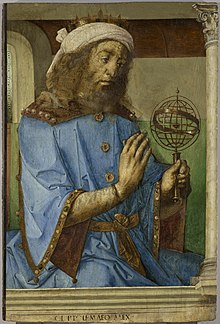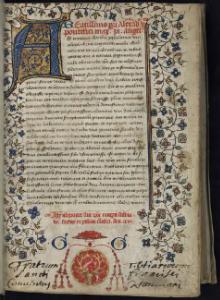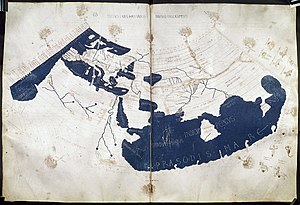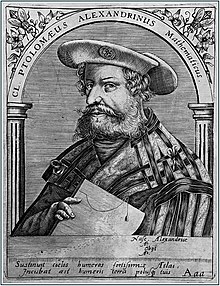
Quick Facts

Biography
Claudius Ptolemy (/ˈtɒləmi/; Greek: Κλαύδιος Πτολεμαῖος, Klaúdios Ptolemaîos, [kláwdios ptolɛmɛ́ːos]; Latin: Claudius Ptolemaeus; c. AD 100 – c. 170) was a Greek writer, known as a mathematician, astronomer, geographer, astrologer, and poet of a single epigram in the Greek Anthology. He lived in the city of Alexandria in the Roman province of Egypt, wrote in Koine Greek, and held Roman citizenship. Beyond that, few reliable details of his life are known. His birthplace has been given as Ptolemais Hermiou in the Thebaid in an uncorroborated statement by the 14th-century astronomer Theodore Meliteniotes. This is a very late attestation, however, and there is no other reason to suppose that he ever lived anywhere else than Alexandria, where he died around AD 168.
Ptolemy wrote several scientific treatises, three of which were of importance to later Byzantine, Islamic and European science. The first is the astronomical treatise now known as the Almagest, although it was originally entitled the "Mathematical Treatise" (Μαθηματικὴ Σύνταξις, Mathēmatikē Syntaxis) and then known as the "Great Treatise" (Ἡ Μεγάλη Σύνταξις, Ē Megálē Syntaxis). The second is the Geography, which is a thorough discussion of the geographic knowledge of the Greco-Roman world. The third is the astrological treatise in which he attempted to adapt horoscopic astrology to the Aristotelian natural philosophy of his day. This is sometimes known as the Apotelesmatika (Ἀποτελεσματικά) but more commonly known as the Tetrabiblos from the Greek (Τετράβιβλος) meaning "Four Books" or by the Latin Quadripartitum.
Background

The name Claudius is a Roman nomen; the fact that Ptolemy bore it indicates he lived under the Roman rule of Egypt with the privileges and political rights of Roman citizenship. It would have suited custom if the first of Ptolemy's family to become a citizen (whether he or an ancestor) took the nomen from a Roman called Claudius who was responsible for granting citizenship. If, as was common, this was the emperor, citizenship would have been granted between AD 41 and 68 (when Claudius, and then Nero, were Roman emperors). The astronomer would also have had a praenomen, which remains unknown.
Ptolemaeus (Πτολεμαῖος – Ptolemaios) is a Greek name. It occurs once in Greek mythology, and is of Homeric form. It was common among the Macedonian upper class at the time of Alexander the Great, and there were several of this name among Alexander's army, one of whom made himself King of Egypt in 323 BC: Ptolemy I Soter. All the kings after him, until Egypt became a Roman province in 30 BC, were also Ptolemies.
Perhaps for no other reason than the association of name, the 9th-century Persian astronomer Abu Ma'shar assumed Ptolemy to be a member of Egypt's royal lineage, stating that the ten kings of Egypt who followed Alexander were wise "and included Ptolemy the Wise, who composed the book of the Almagest". Abu Ma'shar recorded a belief that a different member of this royal line "composed the book on astrology and attributed it to Ptolemy". We can evidence historical confusion on this point from Abu Ma'shar's subsequent remark “It is sometimes said that the very learned man who wrote the book of astrology also wrote the book of the Almagest. The correct answer is not known”. There is little evidence on the subject of Ptolemy's ancestry, apart from what can be drawn from the details of his name (see above); however, modern scholars refer to Abu Ma’shar’s account as erroneous, and it is no longer doubted that the astronomer who wrote the Almagest also wrote the Tetrabiblos as its astrological counterpart.
Ptolemy wrote in Greek and can be shown to have utilized Babylonian astronomical data. He was a Roman citizen, but most scholars conclude that Ptolemy was ethnically Greek, although some suggest he was a Hellenized Egyptian. He was often known in later Arabic sources as "the Upper Egyptian",
suggesting he may have had origins in southern Egypt. Later Arabic astronomers, geographers and physicists referred to him by his name in Arabic: بَطْلُمْيوس Batlamyus.
Astronomy

The Almagest is the only surviving comprehensive ancient treatise on astronomy. Babylonian astronomers had developed arithmetical techniques for calculating astronomical phenomena; Greek astronomers such as Hipparchus had produced geometric models for calculating celestial motions. Ptolemy, however, claimed to have derived his geometrical models from selected astronomical observations by his predecessors spanning more than 800 years, though astronomers have for centuries suspected that his models' parameters were adopted independently of observations. Ptolemy presented his astronomical models in convenient tables, which could be used to compute the future or past position of the planets. The Almagest also contains a star catalogue, which is a version of a catalogue created by Hipparchus. Its list of forty-eight constellations is ancestral to the modern system of constellations, but unlike the modern system they did not cover the whole sky (only the sky Hipparchus could see). Across Europe, the Middle East and North Africa in the Medieval period, it was the authoritative text on astronomy, with its author becoming an almost mythical figure, called Ptolemy, King of Alexandria. The Almagest was preserved, like most of Classical Greek science, in Arabic manuscripts (hence its familiar name). Because of its reputation, it was widely sought and was translated twice into Latin in the 12th century, once in Sicily and again in Spain. Ptolemy's model, like those of his predecessors, was geocentric and was almost universally accepted until the appearance of simpler heliocentric models during the scientific revolution.
His Planetary Hypotheses went beyond the mathematical model of the Almagest to present a physical realization of the universe as a set of nested spheres, in which he used the epicycles of his planetary model to compute the dimensions of the universe. He estimated the Sun was at an average distance of 1,210 Earth radii, while the radius of the sphere of the fixed stars was 20,000 times the radius of the Earth.
Ptolemy presented a useful tool for astronomical calculations in his Handy Tables, which tabulated all the data needed to compute the positions of the Sun, Moon and planets, the rising and setting of the stars, and eclipses of the Sun and Moon. Ptolemy's Handy Tables provided the model for later astronomical tables or zījes. In the Phaseis (Risings of the Fixed Stars), Ptolemy gave a parapegma, a star calendar or almanac, based on the hands and disappearances of stars over the course of the solar year.
The Geography

Ptolemy's other main work is his Geography (also called the Geographia), a compilation of geographical coordinates of the part of the world known to the Roman Empire during his time. He relied somewhat on the work of an earlier geographer, Marinos of Tyre, and on gazetteers of the Roman and ancient Persian Empire. He also acknowledged ancient astronomer Hipparchus for having provided the elevation of the north pole for a few cities.
The first part of the Geography is a discussion of the data and of the methods he used. As with the model of the solar system in the Almagest, Ptolemy put all this information into a grand scheme. Following Marinos, he assigned coordinates to all the places and geographic features he knew, in a grid that spanned the globe. Latitude was measured from the equator, as it is today, but Ptolemy preferredto express it as climata, the length of the longest day rather than degrees of arc: the length of the midsummer day increases from 12h to 24h as one goes from the equator to the polar circle. In books 2 through 7, he used degrees and put the meridian of 0 longitude at the most western land he knew, the "Blessed Islands", often identified as the Canary Islands, as suggested by the location of the six dots labelled the "FORTUNATA" islands near the left extreme of the blue sea of Ptolemy's map here reproduced.


Ptolemy also devised and provided instructions on how to create maps both of the whole inhabited world (oikoumenè) and of the Roman provinces. In the second part of the Geography, he provided the necessary topographic lists, and captions for the maps. His oikoumenè spanned 180 degrees of longitude from the Blessed Islands in the Atlantic Ocean to the middle of China, and about 80 degrees of latitude from Shetland to anti-Meroe (east coast of Africa); Ptolemy was well aware that he knew about only a quarter of the globe, and an erroneous extension of China southward suggests his sources did not reach all the way to the Pacific Ocean.
The maps in surviving manuscripts of Ptolemy's Geography, however, only date from about 1300, after the text was rediscovered by Maximus Planudes. It seems likely that the topographical tables in books 2–7 are cumulative texts – texts which were altered and added to as new knowledge became available in the centuries after Ptolemy. This means that information contained in different parts of the Geography is likely to be of different dates.

Maps based on scientific principles had been made since the time of Eratosthenes, in the 3rd century BC, but Ptolemy improved map projections. It is known from a speech by Eumenius that a world map, an orbis pictus, doubtless based on the Geography, was on display in a school in Augustodunum, Gaul in the third century. In the 15th century, Ptolemy's Geography began to be printed with engraved maps; the earliest printed edition with engraved maps was produced in Bologna in 1477, followed quickly by a Roman edition in 1478 (Campbell, 1987). An edition printed at Ulm in 1482, including woodcut maps, was the first one printed north of the Alps. The maps look distorted when compared to modern maps, because Ptolemy's data were inaccurate. One reason is that Ptolemy estimated the size of the Earth as too small: while Eratosthenes found 700 stadia for a great circle degree on the globe, Ptolemy uses 500 stadia in the Geography. It is highly probable that these were the same stadion, since Ptolemy switched from the former scale to the latter between the Syntaxis and the Geography, and severely readjusted longitude degrees accordingly. See also Ancient Greek units of measurement and History of geodesy.
Because Ptolemy derived many of his key latitudes from crude longest day values, his latitudes are erroneous on average by roughly a degree (2 degrees for Byzantium, 4 degrees for Carthage), though capable ancient astronomers knew their latitudes to more like a minute. (Ptolemy's own latitude was in error by 14'.) He agreed (Geography 1.4) that longitude was best determined by simultaneous observation of lunar eclipses, yet he was so out of touch with the scientists of his day that he knew of no such data more recent than 500 years before (Arbela eclipse). When switching from 700 stadia per degree to 500, he (or Marinos) expanded longitude differences between cities accordingly (a point first realized by P.Gosselin in 1790), resulting in serious over-stretching of the Earth's east-west scale in degrees, though not distance. Achieving highly precise longitude remained a problem in geography until the application of Galileo's Jovian moon method in the 18th century. It must be added that his original topographic list cannot be reconstructed: the long tables with numbers were transmitted to posterity through copies containing many scribal errors, and people have always been adding or improving the topographic data: this is a testimony to the persistent popularity of this influential work in the history of cartography.
Astrology

Ptolemy has been referred to as “a pro-astrological authority of the highest magnitude”. His astrological treatise, a work in four parts, is known by the Greek term Tetrabiblos, or the Latin equivalent Quadripartitum: ‘Four Books’. Ptolemy's own title is unknown, but may have been the term found in some Greek manuscripts: Apotelesmatika, roughly meaning 'Astrological Outcomes,' 'Effects' or ‘Prognostics’.
As a source of reference, the Tetrabiblos is said to have "enjoyed almost the authority of a Bible among the astrological writers of a thousand years or more". It was first translated from Arabic into Latin by Plato of Tivoli (Tiburtinus) in 1138, while he was in Spain. The Tetrabiblos is an extensive and continually reprinted treatise on the ancient principles of horoscopic astrology. That it did not quite attain the unrivaled status of the Almagest was, perhaps, because it did not cover some popular areas of the subject, particularly electional astrology (interpreting astrological charts for a particular moment to determine the outcome of a course of action to be initiated at that time), and medical astrology, which were later adoptions.
The great popularity that the Tetrabiblos did possess might be attributed to its nature as an exposition of the art of astrology, and as a compendium of astrological lore, rather than as a manual. It speaks in general terms, avoiding illustrations and details of practice. Ptolemy was concerned to defend astrology by defining its limits, compiling astronomical data that he believed was reliable and dismissing practices (such as considering the numerological significance of names) that he believed to be without sound basis.
Much of the content of the Tetrabiblos was collected from earlier sources; Ptolemy's achievement was to order his material in a systematic way, showing how the subject could, in his view, be rationalized. It is, indeed, presented as the second part of the study of astronomy of which the Almagest was the first, concerned with the influences of the celestial bodies in the sublunar sphere. Thus explanations of a sort are provided for the astrological effects of the planets, based upon their combined effects of heating, cooling, moistening, and drying.
Ptolemy's astrological outlook was quite practical: he thought that astrology was like medicine, that is conjectural, because of the many variable factors to be taken into account: the race, country, and upbringing of a person affects an individual's personality as much as, if not more than, the positions of the Sun, Moon, and planets at the precise moment of their birth, so Ptolemy saw astrology as something to be used in life but in no way relied on entirely.
A collection of one hundred aphorisms about astrology called the Centiloquium, ascribed to Ptolemy, was widely reproduced and commented on by Arabic, Latin and Hebrew scholars, and often bound together in medieval manuscripts after the Tetrabiblos as a kind of summation. It is now believed to be a much later pseudepigraphical composition. The identity and date of the actual author of the work, referred to now as Pseudo-Ptolemy, remains the subject of conjecture.
Music
Ptolemy also wrote an influential work, Harmonics, on music theory and the mathematics of music. After criticizing the approaches of his predecessors, Ptolemy argued for basing musical intervals on mathematical ratios (in contrast to the followers of Aristoxenus and in agreement with the followers of Pythagoras), backed up by empirical observation (in contrast to the overly theoretical approach of the Pythagoreans). Ptolemy wrote about how musical notes could be translated into mathematical equations and vice versa in Harmonics. This is called Pythagorean tuning because it was first discovered by Pythagoras. However, Pythagoras believed that the mathematics of music should be based on the specific ratio of 3:2, whereas Ptolemy merely believed that it should just generally involve tetrachords and octaves. He presented his own divisions of the tetrachord and the octave, which he derived with the help of a monochord. His Harmonics never had the influence of his Almagest or Planetary Hypotheses, but a part of it (Book III) did encourage Kepler in his own musings on the harmony of the world (Kepler, Harmonice Mundi, Appendix to Book V). Ptolemy's astronomical interests also appeared in a discussion of the "music of the spheres". See: Ptolemy's intense diatonic scale.
Optics
His Optics is a work that survives only in a poor Arabic translation and in about twenty manuscripts of a Latin version of the Arabic, which was translated by Eugene of Palermo (c. 1154). In it Ptolemy writes about properties of light, including reflection, refraction, and colour. The work is a significant part of the early history of optics and influenced the more famous 11th-century Book of Optics by Alhazen (Ibn al-Haytham). It contains the earliest surviving table of refraction from air to water, for which the values (with the exception of the 60° angle of incidence), although historically praised as experimentally derived, appear to have been obtained from an arithmetic progression.
The work is also important for the early history of perception. Ptolemy combined the mathematical, philosophical and physiological traditions. He held an extramission-intromission theory of vision: the rays (or flux) from the eye formed a cone, the vertex being within the eye, and the base defining the visual field. The rays were sensitive, and conveyed information back to the observer’s intellect about the distance and orientation of surfaces. Size and shape were determined by the visual angle subtended at the eye combined with perceived distance and orientation. This was one of the early statements of size-distance invariance as a cause of perceptual size and shape constancy, a view supported by the Stoics. Ptolemy offered explanations for many phenomena concerning illumination and colour, size, shape, movement and binocular vision. He also divided illusions into those caused by physical or optical factors and those caused by judgemental factors. He offered an obscure explanation of the sun or moon illusion (the enlarged apparent size on the horizon) based on the difficulty of looking upwards.
Named after Ptolemy
There are several characters or items named after Ptolemy, including:
- The crater Ptolemaeus on the Moon;
- The crater Ptolemaeus on Mars;
- The asteroid 4001 Ptolemaeus;
- The Ptolemy Stone used in the mathematics courses at both St. John's College campuses.
- Ptolemy's theorem on distances in a cyclic quadrilateral, and its generalization, Ptolemy's inequality, to non-cyclic quadrilaterals
- Ptolemaic graphs, the graphs whose distances obey Ptolemy's inequality
- Mars Labs. Google Maps.
